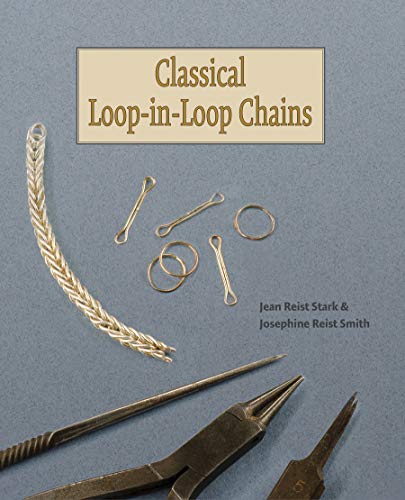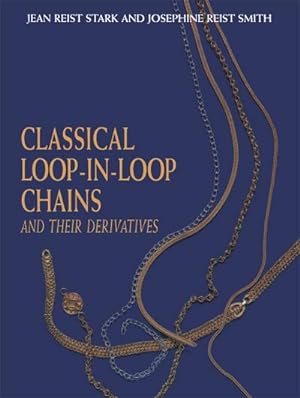Classical Loop in Loop Chains (24 results)
Search filters
Product Type
- All Product Types
- Books (24)
- Magazines & Periodicals (No further results match this refinement)
- Comics (No further results match this refinement)
- Sheet Music (No further results match this refinement)
- Art, Prints & Posters (No further results match this refinement)
- Photographs (No further results match this refinement)
- Maps (No further results match this refinement)
- Manuscripts & Paper Collectibles (No further results match this refinement)
Condition Learn more
- New (19)
- As New, Fine or Near Fine (No further results match this refinement)
- Very Good or Good (3)
- Fair or Poor (No further results match this refinement)
- As Described (2)
Binding
Collectible Attributes
- First Edition (No further results match this refinement)
- Signed (No further results match this refinement)
- Dust Jacket (1)
- Seller-Supplied Images (9)
- Not Print on Demand (23)
Language (2)
Free Shipping
Seller Location
Seller Rating
-
Condition: Good. This is an ex-library book and may have the usual library/used-book markings inside.This book has soft covers. In good all round condition. Please note the Image in this listing is a stock photo and may not match the covers of the actual item,750grams, ISBN:9780713653526.
-
Classical Loop-in-Loop Chains: And Their Derivatives
Seller: Bay State Book Company, North Smithfield, RI, U.S.A.
Condition: very_good.
-
Hardcover-spiral. Condition: Very Good. Connecting readers with great books since 1972! Used books may not include companion materials, and may have some shelf wear or limited writing. We ship orders daily and Customer Service is our top priority!
-
Hardcover. Condition: Brand New. Jean Stark (illustrator). 2nd edition. 200 pages. 10.50x8.50x0.80 inches. In Stock.
-
Hardcover. Condition: New. Dust Jacket Condition: New. Jean Stark (illustrator). 2nd Edition. In shrink wrap.
-
Paperback. Condition: new. Excellent Condition.Excels in customer satisfaction, prompt replies, and quality checks.
-
Classical Loop-in-Loop Chains (Paperback)
Language: English
Published by Chapman and Hall, London, 1997
ISBN 10: 0412078813 ISBN 13: 9780412078811
Seller: Grand Eagle Retail, Bensenville, IL, U.S.A.
Paperback. Condition: new. Paperback. Over the last decade many goldsmiths and jewellery designers have been inspired by jewellery of the ancient world, and have drawn upon classical loop-in-loop chains to create contemporary jewellery designs. This manual describes and illustrates procedures for making a variety of chains based on ancient loop-in-loop techniques. The illustrations by the author guide the reader, with a previous knowledge of the basics of goldsmithing, through the procedures of making these chains without assistance. Actually gold was cold worked as if it were a stone. There were only four metals on the earth's surface that were found in sufficient quantity to be used: gold, copper, silver, and meteoric iron. Gold was no longer a piece of stone but a material that could be flattened and made very thin. Sheet and foil are the oldest forms of worked gold. Shipping may be from multiple locations in the US or from the UK, depending on stock availability.
-
Classical Loop-in-Loop Chains: And Their Derivatives
Language: English
Published by Kluwer Academic Publishers, 1997
ISBN 10: 0412078813 ISBN 13: 9780412078811
Seller: BennettBooksLtd, San Diego, NV, U.S.A.
paperback. Condition: New. In shrink wrap. Looks like an interesting title!
-
Condition: New.
-
Classical Loop-In-Loop Chains: And Their Derivatives
Seller: Chiron Media, Wallingford, United Kingdom
PF. Condition: New.
-
Classical Loop-in-Loop Chains
Language: English
Published by Springer US, Springer US Jan 1997, 1997
ISBN 10: 0412078813 ISBN 13: 9780412078811
Seller: BuchWeltWeit Ludwig Meier e.K., Bergisch Gladbach, Germany
Taschenbuch. Condition: Neu. Neuware -ThiS is not only a book of instruction in chainmaking but it is also a work celebrating man's continuous creativity over thousands of years. At times something that man creates has far-reach ing effects; an example that quickly comes to mind is the wheel, which has enabled many devel opments, from pottery to computers. At this point it is important to note that these same wheels could not have been made without metal tools. From early Neolithic times on gold was a favorite choice in the making of jewelry. During the Neolithic period these 'shining stones,' probably alluvial, were prized. Actually gold was cold worked as if it were a stone. There is a surviving example of cold-worked gold from Catahuyuk (present day Turkey) estimated to have been made in 6500 B. C. There were only four metals on the earth's surface that were found in sufficient quantity to be used: gold, copper, silver, and meteoric iron. An understanding of the malleability of gold, and of the annealing effect of fire, changed jewelry making; new forms were found. Gold was no longer a piece of stone but a material that could be flattened and made very thin. Sheet and foil are the oldest forms of worked gold. The smiths' tools were stone, wood, and horn. 212 pp. Englisch.
-
Condition: New.
-
Classical Loop-in-Loop Chains
Language: English
Published by Chapman and Hall, GB, 1997
ISBN 10: 0412078813 ISBN 13: 9780412078811
Seller: Rarewaves.com USA, London, LONDO, United Kingdom
£ 138.15
Free Shipping
Ships from United Kingdom to U.S.A.Quantity: Over 20 available
Add to basketPaperback. Condition: New. Over the last decade many goldsmiths and jewellery designers have been inspired by jewellery of the ancient world, and have drawn upon classical loop-in-loop chains to create contemporary jewellery designs. This manual describes and illustrates procedures for making a variety of chains based on ancient loop-in-loop techniques. The illustrations by the author guide the reader, with a previous knowledge of the basics of goldsmithing, through the procedures of making these chains without assistance. Softcover reprint of the original 1st ed. 1997.
-
Paperback. Condition: new. Excellent Condition.Excels in customer satisfaction, prompt replies, and quality checks.
-
Classical Loop-in-loop Chains and Their Derivatives
Language: English
Published by A & C Black Publishers Ltd, 2007
ISBN 10: 071368769X ISBN 13: 9780713687699
Seller: Cotswold Internet Books, Cheltenham, United Kingdom
Condition: Used - Very Good. VG hardback. 2007 reprint in new format with wire spiral binding; laminated pictorial boards; numerous B&W illustrations; a very clean, tidy copy.
-
Taschenbuch. Condition: Neu. Classical Loop-in-Loop Chains | And Their Derivatives | J. R. Smith | Taschenbuch | xviii | Englisch | 1997 | Springer | EAN 9780412078811 | Verantwortliche Person für die EU: Springer Verlag GmbH, Tiergartenstr. 17, 69121 Heidelberg, juergen[dot]hartmann[at]springer[dot]com | Anbieter: preigu.
-
Classical Loop-in-Loop Chains
Language: English
Published by Springer US, Springer US Jan 1997, 1997
ISBN 10: 0412078813 ISBN 13: 9780412078811
Seller: buchversandmimpf2000, Emtmannsberg, BAYE, Germany
Taschenbuch. Condition: Neu. Neuware -ThiS is not only a book of instruction in chainmaking but it is also a work celebrating man's continuous creativity over thousands of years. At times something that man creates has far-reach ing effects; an example that quickly comes to mind is the wheel, which has enabled many devel opments, from pottery to computers. At this point it is important to note that these same wheels could not have been made without metal tools. From early Neolithic times on gold was a favorite choice in the making of jewelry. During the Neolithic period these 'shining stones,' probably alluvial, were prized. Actually gold was cold worked as if it were a stone. There is a surviving example of cold-worked gold from Catahuyuk (present day Turkey) estimated to have been made in 6500 B. C. There were only four metals on the earth's surface that were found in sufficient quantity to be used: gold, copper, silver, and meteoric iron. An understanding of the malleability of gold, and of the annealing effect of fire, changed jewelry making; new forms were found. Gold was no longer a piece of stone but a material that could be flattened and made very thin. Sheet and foil are the oldest forms of worked gold. The smiths' tools were stone, wood, and horn.Springer Verlag GmbH, Tiergartenstr. 17, 69121 Heidelberg 212 pp. Englisch.
-
Hardcover. Condition: new. Excellent Condition.Excels in customer satisfaction, prompt replies, and quality checks.
-
Condition: New. Supporting Bay Area Friends of the Library since 2010. Well packaged and promptly shipped.
-
Classical Loop-in-Loop Chains : And Their Derivatives
Language: English
Published by Springer US, Springer US, 1997
ISBN 10: 0412078813 ISBN 13: 9780412078811
Seller: AHA-BUCH GmbH, Einbeck, Germany
Taschenbuch. Condition: Neu. Druck auf Anfrage Neuware - Printed after ordering - ThiS is not only a book of instruction in chainmaking but it is also a work celebrating man's continuous creativity over thousands of years. At times something that man creates has far-reach ing effects; an example that quickly comes to mind is the wheel, which has enabled many devel opments, from pottery to computers. At this point it is important to note that these same wheels could not have been made without metal tools. From early Neolithic times on gold was a favorite choice in the making of jewelry. During the Neolithic period these 'shining stones,' probably alluvial, were prized. Actually gold was cold worked as if it were a stone. There is a surviving example of cold-worked gold from Catahuyuk (present day Turkey) estimated to have been made in 6500 B. C. There were only four metals on the earth's surface that were found in sufficient quantity to be used: gold, copper, silver, and meteoric iron. An understanding of the malleability of gold, and of the annealing effect of fire, changed jewelry making; new forms were found. Gold was no longer a piece of stone but a material that could be flattened and made very thin. Sheet and foil are the oldest forms of worked gold. The smiths' tools were stone, wood, and horn.
-
Classical Loop-in-Loop Chains (Paperback)
Language: English
Published by Chapman and Hall, London, 1997
ISBN 10: 0412078813 ISBN 13: 9780412078811
Seller: AussieBookSeller, Truganina, VIC, Australia
Paperback. Condition: new. Paperback. Over the last decade many goldsmiths and jewellery designers have been inspired by jewellery of the ancient world, and have drawn upon classical loop-in-loop chains to create contemporary jewellery designs. This manual describes and illustrates procedures for making a variety of chains based on ancient loop-in-loop techniques. The illustrations by the author guide the reader, with a previous knowledge of the basics of goldsmithing, through the procedures of making these chains without assistance. Actually gold was cold worked as if it were a stone. There were only four metals on the earth's surface that were found in sufficient quantity to be used: gold, copper, silver, and meteoric iron. Gold was no longer a piece of stone but a material that could be flattened and made very thin. Sheet and foil are the oldest forms of worked gold. Shipping may be from our Sydney, NSW warehouse or from our UK or US warehouse, depending on stock availability.
-
Classical Loop-in-Loop Chains
Language: English
Published by Chapman and Hall, GB, 1997
ISBN 10: 0412078813 ISBN 13: 9780412078811
Seller: Rarewaves.com UK, London, United Kingdom
£ 127.32
£ 65 shipping
Ships from United Kingdom to U.S.A.Quantity: Over 20 available
Add to basketPaperback. Condition: New. Over the last decade many goldsmiths and jewellery designers have been inspired by jewellery of the ancient world, and have drawn upon classical loop-in-loop chains to create contemporary jewellery designs. This manual describes and illustrates procedures for making a variety of chains based on ancient loop-in-loop techniques. The illustrations by the author guide the reader, with a previous knowledge of the basics of goldsmithing, through the procedures of making these chains without assistance. Softcover reprint of the original 1st ed. 1997.
-
Classical Loop-in-Loop Chains & Their Derivatives.
Published by Portland, ME: Brynmorgen Press, [1999]., 1999
Seller: D & E LAKE LTD. (ABAC/ILAB), Toronto, ON, Canada
4to. pp. xviii, 190. profusely illus. glossary index. pictorial bds. Fine copy. Third Printing.
-
Classical Loop-in-Loop Chains: And Their Derivatives
Seller: THE SAINT BOOKSTORE, Southport, United Kingdom
£ 114.67
£ 16.05 shipping
Ships from United Kingdom to U.S.A.Quantity: Over 20 available
Add to basketPaperback / softback. Condition: New. This item is printed on demand. New copy - Usually dispatched within 5-9 working days 530.















